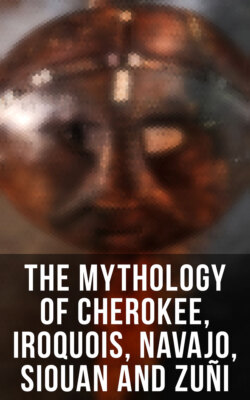Читать книгу The Mythology of Cherokee, Iroquois, Navajo, Siouan and Zuñi - James Mooney - Страница 48
На сайте Литреса книга снята с продажи.
Face-Painting
ОглавлениеA first-hand account of how the Indian brave decorated his face cannot but prove of interest. Says a writer who dwelt for some time among the Sioux:13
"Daily, when I had the opportunity, I drew the patterns their faces displayed, and at length obtained a collection, whose variety even astonished myself. The strange combinations produced in the kaleidoscope may be termed weak when compared to what an Indian's imagination produces on his forehead, nose, and cheek. I will try to give some account of them as far as words will reach. Two things struck me most in their arrangement of colour. First, the fact that they did not trouble themselves at all about the natural divisions of the face; and, secondly, the extraordinary mixture of the graceful and the grotesque. At times, it is true, they did observe those natural divisions produced by nose, eyes, mouth, etc. The eyes were surrounded with regular coloured circles; yellow or black stripes issued harmoniously and equidistant from the mouth; over the cheeks ran a semicircle of green dots, the ears forming the centre. At times, too, the forehead was traversed by lines running parallel to the natural contour of that feature; this always looked somewhat human, so to speak, because the fundamental character of the face was unaltered. Usually, however, these regular patterns do not suit the taste of the Indians. They like contrasts, and frequently divide the face into two halves, which undergo different treatment; one will be dark—say black or blue—but the other quite light, yellow, bright red, or white: one will be crossed by thick lines made by the forefingers, while the other is arabesque, with extremely fine lines, produced by the aid of a brush.
"This division is produced in two different ways. The line of demarcation sometimes runs down the nose, so that the right cheek and side are buried in gloom, while the left looks like a flower-bed in the sunshine. At times, though, they draw the line across the nose, so that the eyes glisten out of the dark colour, while all beneath the nose is bright and lustrous. It seems as if they wished to represent on their faces the different phases of the moon. I frequently inquired whether there was any significance in these various patterns, but was assured it was a mere matter of taste. They were simple arabesques, like their squaws' work on the moccasins, girdles, tobacco-pouches, etc.
"Still there is a certain symbolism in the use of the colours. Thus, red generally typifies joy and festivity; and black mourning. When any very melancholy death takes place, they rub a handful of charcoal over the entire face. If the deceased is only a distant relative, a mere trellis-work of black lines is painted on the face; they have also a half-mourning, and only paint half the face black. Red is not only their joy, but also their favourite colour. They generally cover their face with a coating of bright red, on which the other colours are laid; for this purpose they employ vermilion, which comes from China, and is brought them by the Indian traders. However, this red is by no means de rigueur. Frequently the ground colour is a bright yellow, for which they employ chrome-yellow, obtained from the trader.
"They are also very partial to Prussian blue, and employ this colour not only on their faces, but as a type of peace on their pipes; and as the hue of the sky, on their graves. It is a very curious fact, by the way, that hardly any Indian can distinguish blue from green. I have seen the sky which they represent on their graves by a round arch, as frequently of one colour as the other. In the Sioux language toya signifies both green and blue; and a much-travelled Jesuit Father told me that among many Indian tribes the same confusion prevails. I have also been told that tribes have their favourite colours, and I am inclined to believe it, although I was not able to recognize any such rule. Generally all Indians seem to hold their own native copper skin in special affection, and heighten it with vermilion when it does not seem to them sufficiently red.
"I discovered during a journey I took among the Sioux that there is a certain national style in this face-painting. They were talking of a poor Indian who had gone mad, and when I asked some of his countrymen present in what way he displayed his insanity, they said, 'Oh, he dresses himself up so funnily with feathers and shells; he paints his face so comically that it is enough to make one die of laughing.' This was said to me by persons so overladen with feathers, shells, green and vermilion, Prussian blue, and chrome-yellow, that I could hardly refrain from smiling. Still, I drew the conclusion from it that there must be something conventional and typical in their variegated style which might be easily infringed."
